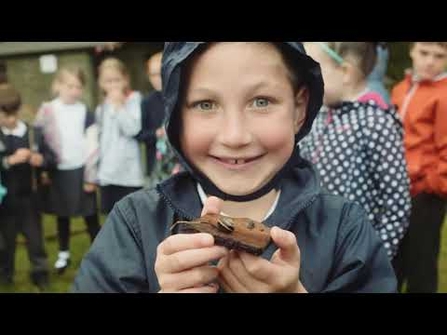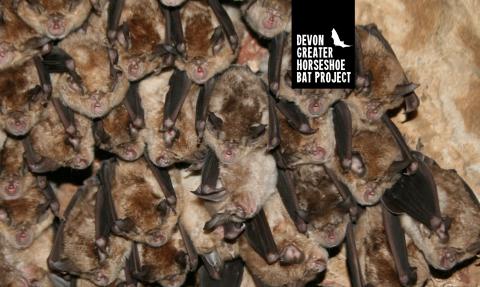
Photo, Devon Greater Horseshoe Bat Project
Devon Greater Horseshoe Bat Project
Devon's nocturnal wonder
The population of Greater Horseshoe Bats (GHB) declined by 90% in the UK during the last 100 years. Similar trends are seen across northern Europe, with Devon now a stronghold for the species.
This project has now ended but during its 5 year history enabled people to learn about, celebrate and help to care for these enigmatic bats and the landscape they live in. Find out more below.
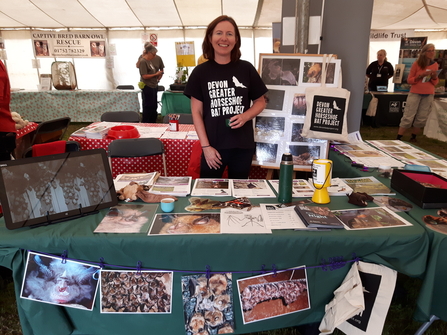
About this project
The Devon Greater Horseshoe Bat Project was a 5 year partnership project of 18 organisations led by Devon Wildlife Trust and was supported by the National Lottery Heritage Fund, as well as other funders.
Our aim was to secure the future of the greater horseshoe bat in Devon, the northern European stronghold of this highly threatened mammal. The team worked with local communities and landowners to secure a future for greater horseshoe bats in Devon.
The Devon Greater Horseshoe Bat Project Summary
Click below to read the summary of the Devon Greater Horseshoe Bat Project achievements including the results from the Devon Bat Survey.
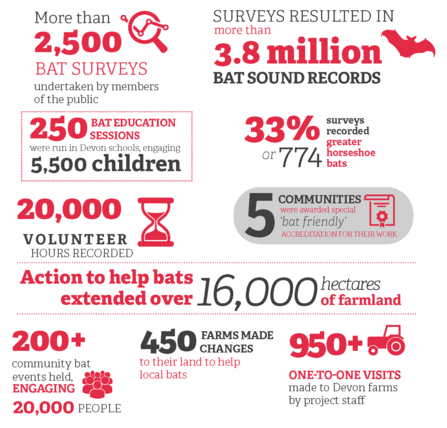
Read the final survey report here...
Watch our bat videos
Visit the Devon Wildlife Trust YouTube channel for bat videos, including bat roost films, land management and the September 2020 online conference!
How to get involved....
Although this project has ended, there are lots of fantastic resources, activities and bat information for you to enjoy. Whether you are an individual, school, community group, landowner or planner you will find something of interest.
Individuals and Families
There are plenty of ways you can help bats at home, which also benefit other wildlife. See our Wild About Gardens 'Stars of the Night' guide for tips on wildlife ponds, insects hotels, bat boxes and more!
Why not go on a bat trail? We have 11 bat walks in different parts of Devon for you to explore, including areas where bats live! To download a trail sheet, see the links below (please note that these have not been updated since the project ended).
Schools - Bat Buddy Award
What is the Bat Buddy Award?
The Bat Buddy Award is a fantastic way to get young people enthusiastic about bats and other wildlife. Often concerned about the climate emergency the Bat Buddy awards empowers young people to take action locally where they can really make a difference. It’s fun and simple to take part. Children and adults love learning about this enigmatic but endangered creature living on their doorstep here in Devon.
Who can take part?
Anyone working in schools or with children. You don’t have to live in Devon to take part. Greater Horseshoe Bats live only in the south west of England and south Wales. However, other species of bats are found across the whole of the UK so the award can be done anywhere.
Simply do 10 activities for each level of Bronze, Silver and Gold. Once you complete 10 activities for your chosen level, you can then print your Bat Buddy Award certificate.
Sign up for the Bat Buddy Award here.
Find our education resources, including games and factsheets, here.
Community groups
There are many ways you can enhance the environment in your community for bats, including reducing artificial lighting in key habitats and managing road verges to provide species rich habitats. You can find guidance below.
A key aspect of bat conservation is providing habitats for insects, their food source. 41% of insect species face extinction due to habitat loss and overuse of pesticides, but it's not too late. Join our Action For Insects campaign to help put insects into recovery. You can also find our community guide on how to help insects below.
To find out more about how you can help bats and make a difference to your local environment, contact the Devon Bat Group.
Landowners
Landowners who carry out sensitive countryside management can really improve the feeding areas and habitats for greater horseshoe bats.
During the course of the project, our Advisory Officers completed 950 farm visits. In addition, they organised and delivered in excess of 100 landowner workshops on a wide variety of topics relating to greater horseshoe bats and wider environmental management. Workshops on the subject of Countryside Stewardship grant schemes were particularly well received, as was the detailed follow-up advice and ongoing support offered by the team’s Advisory Officers in helping landowners to put their applications together.
You can find our management guides below.
Responding to planning applications
Local Planning Authorities and Greater Horseshoe Bats
Local Planning Authorities must give due consideration to all protected bat species, including greater horseshoe bats and their habitat requirements when assessing planning applications, listed building consents, and other permits.
Applications should not be considered in isolation but rather assessed in combination with existing and proposed developments to prevent unforeseen cumulative effects on bats and the creation of pinch points within the landscape.
DWT has produced a guide to responding to planning applications so residents can best shape any objections to a development due to concerns about the impact on species and habitats. You can find the DIY Planning Guide as a PDF here.
See further guidance on bats and planning below.
Bat Facts
Where does the bat get its name?
The Greater Horseshoe Bat is named after its horseshoe shaped nose ‘leaf’, used as part of the bat’s echolocation system. The ears are leaf-shaped and have a sharply pointed tip, while the thick fur is coloured ash-grey.
Can bats see in the dark?
Like all bats greater horseshoes use a system called echolocation, making high frequency calls as they fly and listen to the returning echoes to build up a sonic map of their surroundings. Most bats shout sounds from their mouths but the greater horseshoes unusual-shaped ‘nose-leaf’ allows them to concentrate the sounds really effectively like the foil behind a torch bulb.
How long can bats live for?
Greater horseshoe bats can live for up to 30 years due to their large amounts of torpor and low numbers of young (one pup per year). For an animal that weighs just 30g (the same as 3 pound coins) this is very unusual – a 25g wood mouse lives for just 18 months.
Predator or Prey?
Both
While greater horseshoes are voracious hunters, they are also food for bigger animals. Sparrowhawks often pick off bats as they leave a roost, and owls will take them too. But their biggest enemy is the domestic cat who will take them in their roosts or as they fly low along hedges.
How do these bats feed?
HAWKING & PERCH-HUNTING
Greater horseshoes feed in two main ways:
– Hawking – catching and eating insects in the air during flight.
– Perch-hunting – flying out or ambushing from a hedge, catching the prey and returning to the hedge to dismember and eat it (while hanging upside down from a hedgerow tree).
What do they eat?
Greater horseshoes only live in landscapes where all the following are found – like Devon.
-
COCKCHAFER - A large beetle, a perfect meal for a greater horseshoe. The Cockchafer beetle likes meadows rich in grasses and flowers.
-
MOTHS - Moths provide 40% of the greater horseshoe’s diet, without them bats couldn’t survive!
-
THE DUNG BEETLE - A favourite food of greater horseshoes. Most important are those on cow pats. Dung (poo) is home to 40 species of dung beetle in Britain, which are a favourite food of greater horseshoes. Most important are those on cow pats.
Thanks to all the partners who supported the project...
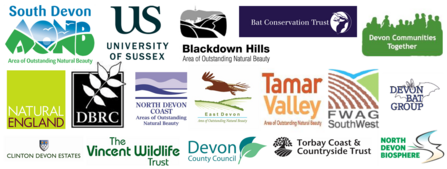
Thanks to the funders who made this project possible...
| Main Funder: National Lottery Heritage Fund |
| 29th May 1961 Charitable Trust | The Halpin Trust |
| D’Oyly Carte Charitable Trust | The Hawthorn Trust |
| Disney Conservation Fund | The Keith Ewart Charitable Trust |
| Dr and Mrs Alfred Darlington Charitable Trust | The Linley Wightman Shaw Foundation |
| Environment Agency | The Spear Charitable Trust |
| Ratcliff Foundation | The St Mary’s Charity Sir |
| Sir John and Lady Amory’s Charitable Trust | West Devon Borough Council |
| The Adrian Swire Charitable Trust | Wildlife Acoustics (in kind) |
| The Clark Bradbury Trust |

